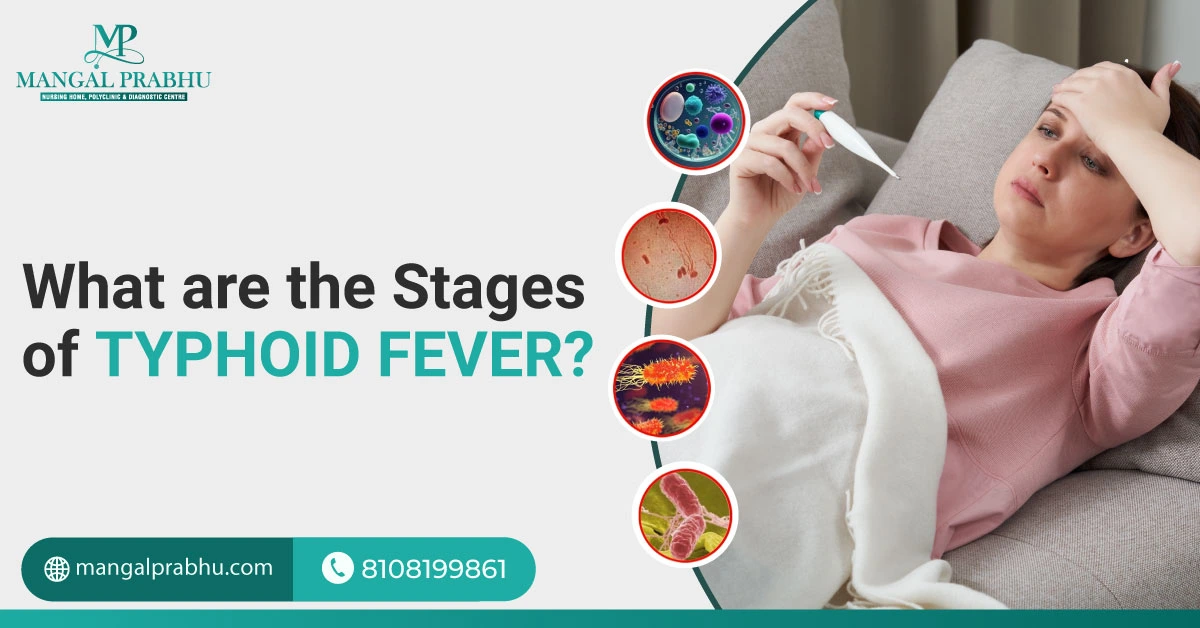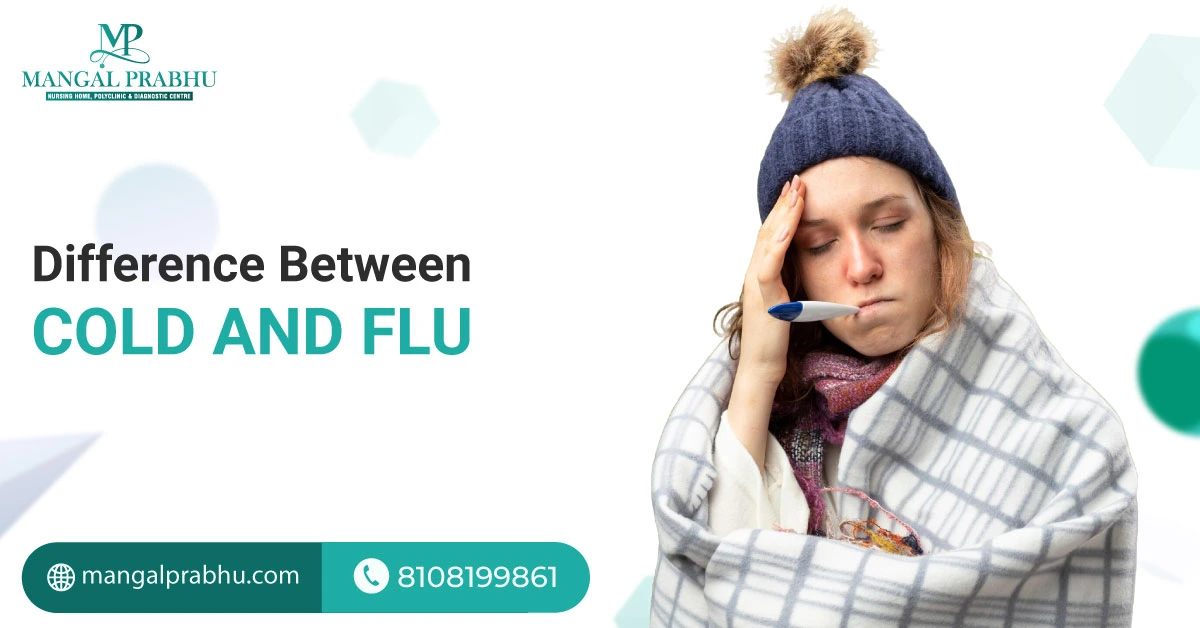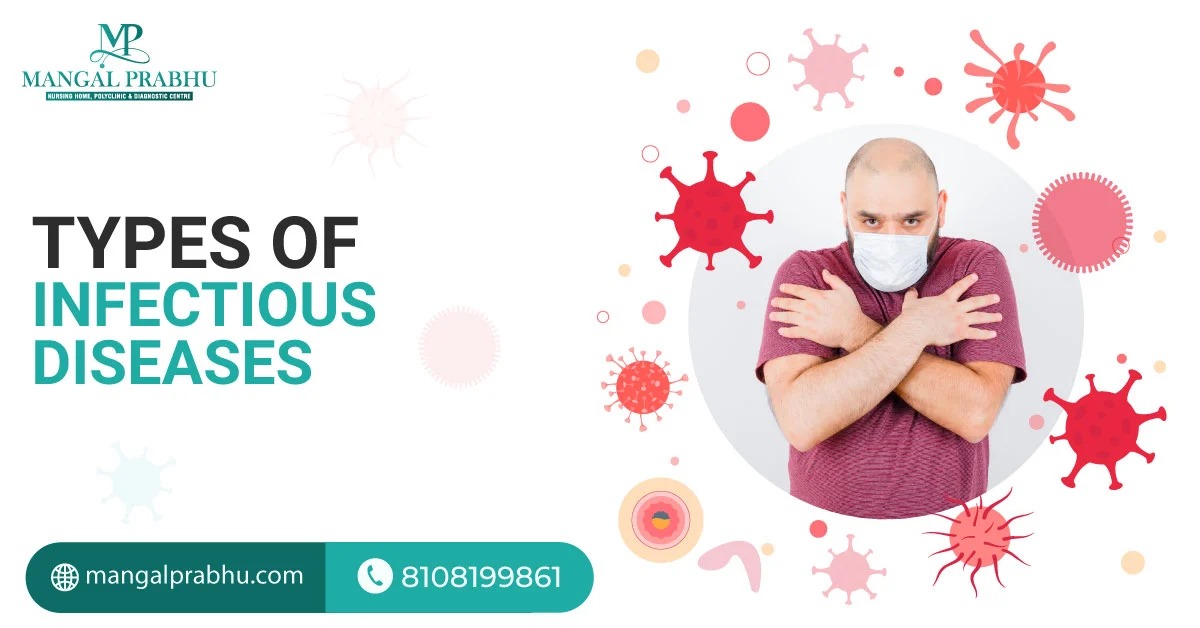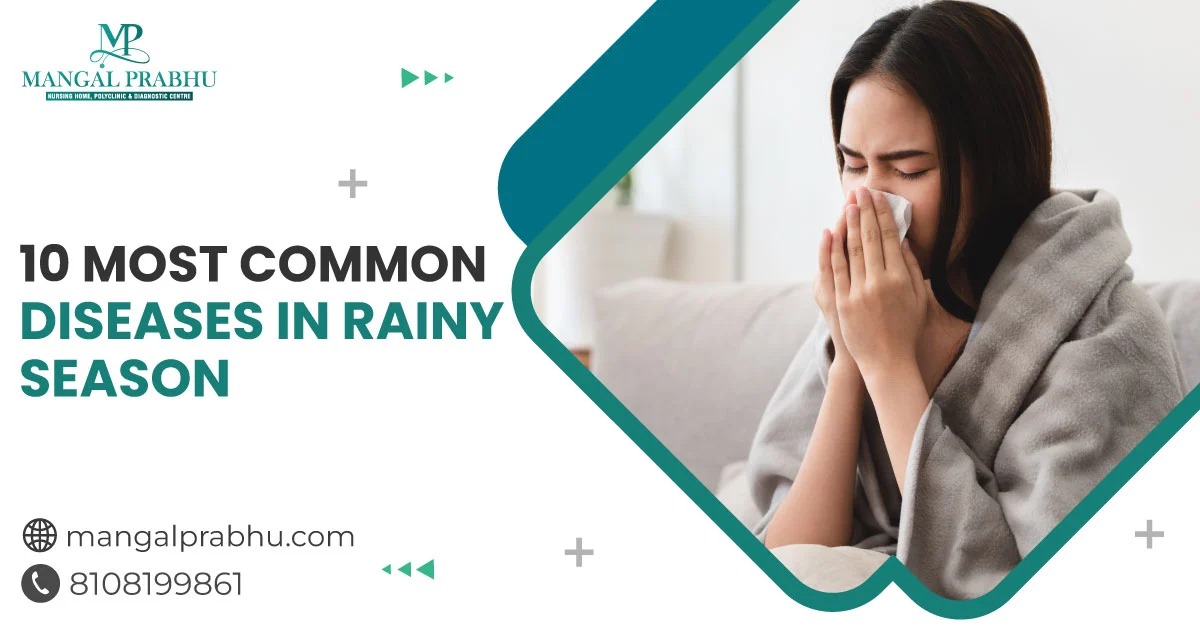
What are the Stages of Typhoid Fever?
Typhoid fever is a critical, contagious illness that occurs when the bacteria “Salmonella Typhi” enter your system and multiply within the bloodstream and intestines. People living in places where poor sanitation practices are followed are prone to contracting the illness.
It’s important that you know the different stages of typhoid fever, how it spreads, and, more importantly, prevention steps to minimize your risk of getting typhoid. If you suspect typhoid, seek immediate medical care from a General Physician in Navi Mumbai to reduce your risk of complications. In this post, we’ll walk you through the early and advanced stages of typhoid. Let’s take a look:
What are the Stages of Typhoid Fever?
Stage 1: Early Symptoms
The symptoms of typhoid aren’t noticeable in most cases during the incubation period or the early stage of the disease. This can start in the first few days of contracting the bacteria or up to 60 days. The severity of this contagious illness depends on your immunity and the bacterial strain ingested.
Stage 2: Acute Illness
Symptoms show up during this phase. As it progresses, you will notice high-grade fever, often spiking to 104°F, accompanied by muscle aches, fatigue, headache, and loss of appetite. The acute stage of typhoid fever can last for days and can lead to complications if left unaddressed for a long time. The symptoms start with a mild fever, which progresses gradually. Remember, the gradually increasing temperature and persistent fever are key indicators of typhoid.
Stage 3: Peak of Infection
If your doctor starts antibiotics during the acute phase, the symptoms will subside, and you’ll feel better. However, if the treatment isn’t started, the symptoms might worsen due to the bacteria spreading to the bloodstream and intestines. Some people report constipation, while others experience diarrhea. Abdominal pain is also common at this stage. You might experience difficulty concentrating due to the high-grade fever.
If you experience these symptoms, especially if your temperature doesn’t drop, visit the nearest hospital for typhoid treatment in Navi Mumbai. Delayed treatment can increase the risk of complications, including intestinal bleeding and septic shock.
Stage 4: Recovery
Also called the Convalescence stage, your body goes into the recovery phase. Your immune system fights off the infection, which may help subside the fever and manage other symptoms. Still, some patients report muscle aches, fatigue, and weakness for several weeks after the acute phase.
It’s important to follow your doctor’s advice and complete your course of antibiotics, even if the symptoms have subsided. Skipping medication can lead to the bacteria resurfacing.
Prevention Tips
To help mitigate the risk of typhoid, we have listed a few preventive measures that can help.
- Make a habit of washing your hands thoroughly before eating.
- Carry bottled water or boiled water when traveling.
- Avoid high-risk areas, especially if you have weak immunity.
- Vaccination is also available for those with an increased risk of contracting typhoid.
- Never eat veggies and fruits without washing them.
Conclusion
The symptoms of typhoid are often confused with flu and common cold. That’s why many people do not visit the hospital until the condition worsens and the fever doesn’t subside. The earlier you seek medical care, the better your chances of recovering quickly.

Difference Between Cold and Flu
Difference Between Cold and Flu
You wake up with a scratchy throat, cough, runny nose, and sneezing. Just when you think it might be a cold, fever and muscle ache kick in. It’s hard to know if you have a cold or influenza (flu), especially in the colder months when both are quite prevalent. Understanding the difference between cold and flu can help you prepare for both and pick a general physician in Navi Mumbai based on what you have. To help you differentiate between the two, we’ve researched some key tips you must watch out for.
Symptoms of a Common Cold and Flu
Cold and flu share many common symptoms, but the flu shows comparatively more intense and long-lasting symptoms compared to the common cold. If it’s just a cold, the symptoms will appear gradually, while flu symptoms occur abruptly. Cold starts with a scratchy throat followed by these symptoms:
- Runny nose
- Sneezing
- Fatigue
- Nasal congestion
Flu has all these symptoms and some additional issues like:
- Fever
- Body ache
- Extreme fatigue
- Chills and shivers
- Headaches
- Cough
Some people, particularly children, also experience nausea and vomiting with the above symptoms.
Causes and Transmission
There are more than 200 types of viruses responsible for the common cold in children and adults. Rhinoviruses are the most common. Influenza A, B, and C viruses are responsible for flu. A and B are common. Both are transmitted through sneezing, coughing, or touching contaminated surfaces.
Diagnosis and Testing
Colds have a symptom-based diagnosis. Your doctor will ask about what you are experiencing and check your throat and nose to detect any mucus buildup. If you have flu symptoms, like fever and body aches, your doctor will check your breathing and lung function to rule out pneumonia and other lung-related complications.
In high-risk individuals, like elders, kids, and those with a compromised immune system, the doctor will order a rapid influenza diagnostic test (RIDT) or a molecular assay to get an accurate diagnosis. The tests tell the strain of the virus that’s caused the flu.
Treatment and Management
Cold and flu treatment in Navi Mumbai mainly comprises rest. Given the less severe symptoms of a cold, rest and hydration are sufficient. You can also take over-the-counter medication for throat irritation or other symptoms, although these are not usually needed.
Your symptoms will resolve on their own within 7-10 days, and you’ll be back to feeling normal. Flu, however, can be long-lasting. It usually takes a week or two to resolve completely. In some cases, antiviral medication might be prescribed to prevent complications.
Prevention Strategies
Cold and flu can be prevented with basic hygiene practices, like washing your hands, avoiding sick people, and using masks. Flu vaccination can help minimize the risk of catching flu and prepare your immune system to fight off the infection if you contract the influenza virus. Both viral illnesses show similar symptoms and are preventable with good hygiene, but the flu tends to present critical symptoms. It can get better with home remedies, but some cases require medical intervention, especially if the symptoms persist for long or are likely to lead to complications.

Types of Infectious Diseases
What is Infectious Disease?
Infectious diseases are caused by microorganisms, commonly called pathogens, that enter the human body and multiply. The symptoms, severity, prevention, and treatment of contagious illnesses vary depending on the type of pathogen that infects your body. It can be bacteria, fungal, viral, or parasitic.
The infection usually spreads through bodily fluid exchange, insect bites, skin-to-skin contact, ingesting contaminated liquids or food, and inhaling the contaminated droplets. Whether or not you need infectious disease treatment in Navi Mumbai depends on the type of infectious disease you’ve contracted. Let’s explore the most common ones.
1) Bacterial Infections
Bacteria are found in the human body and the environment. There are trillions of strains of bacteria, some of which are harmless and thrive in our body to fight bad bacteria. Others are, however, harmful enough to cause sickness from releasing toxins. Some severe bacteria-induced illnesses are:
- Strep throat
- Tuberculosis
- Cholera
- Typhoid
- Pneumonia
- Urinary Track Infections (UTIs)
Bacterial infections require antibiotics.
2) Viral Infections
Viruses are not capable of replicating themselves without support. They invade your cells to make multiple copies of themselves. Some viruses cause mild infections, like the common cold and flu. Others can lead to severe and life-threatening illnesses like HPV (that can turn into cancer). They spread from touching contaminated surfaces or if an infected person sneezes or coughs near you. Some common viral illnesses include:
- Common cold
- Coronavirus
- Hepatatits C
- Dengu
- Polio
- HIV
Viral infections do not respond to antibiotics. Fortunately, most mild viral illnesses will disappear with rest, over-the-counter medication, and increased fluid intake. Serious viral infections, like HIV and HPV, may require advanced antiviral treatment.
3) Fungal Infections
Fungal infections usually affect the upper layers of the skin but can go deeper in some cases. Ringworm, athlete’s foot, and candidiasis are the most common fungal infections. Although anyone can develop a fungal infection, people with a weakened immune system are at an increased risk.
If the condition affects your respiratory system, mouth, and other vital organs, you may need to see an infectious disease specialist in Navi Mumbai. Treatment usually involves topical and anti-fungal oral medication, although intravenous administration might sometimes be necessary.
4) Parasitic Infections
Parasites can invade your body and take nutrients from you to thrive. Parasitic infections cause abdominal discomfort, vomiting, diarrhea, and other intestinal symptoms, although they can affect the brain, lungs, and other organs too.
Tapeworm infection, for instance, are the common type of parasitic infection. They enter your body through undercooked meat. They don’t usually produce symptoms, but can cause severe neurological symptoms if they enter the brain. Other examples of parasite-based infections include:
- Malaria
- Toxoplasmosis
- Chagas
- Pinworms
- Cyclosporiasis
Antiparaistics are prescribed to treat parasitic infections. These can be used as standalone treatment or with antibiotics and antifungals.
Conclusion
Some infectious diseases are mild enough to resolve on their own within a few days, while others are severe and might even require hospitalization. To prevent infectious diseases, wash and sanitize your hands frequently, avoid contact with infected people, do not ear raw eggs or meat, and get vaccination.

10 Most Common Diseases in Rainy Season
Finally, the monsoon has arrived. You can bid goodbye to the scorching summer heat and welcome this reliving season. But, with monsoon comes the risks of viral, bacterial, and other water-borne and food-borne diseases, some of which can be fatal.
Regular checkups with a general physician in Navi Mumbai are important, but it’s equally crucial to seek medical help immediately if you experience flu symptoms. In the meantime, this article delves into the 10 most common diseases in the monsoon.
10 Most Common Diseases in Rainy Season
1) Common Cold and Flu:
Temperature fluctuation and increased humidity make the common cold and flu more prevalent in people during monsoons. Viruses tend to survive easily in humid environments, increasing the chances of transmission. Simple steps, like avoiding crowded places and keeping your indoors ventilated and hygienic, can help prevent the common cold.
2) Dengue Fever:
Dengue, which can turn fatal, is caused by Aedes mosquitoes and is more common during the monsoon, as stagnant water in the surroundings can be the breeding ground for insects. Symptoms include high-grade fever, rash, hypersensitivity, and low platelet count.
3) Malaria:
Like dengue, malaria is a mosquito-borne disease. It spreads through Plasmodium parasites. Malaria is more common during the rainy season, especially in places with clean, stagnant water. The infected mosquito can transfer this illness through a bite. Symptoms include headache, fever, chills, sweating, and anemia.
4) Leptospirosis:
This bacterial infection transmits from animals to humans. If you have bruises, scratched skin, or any unhealed wound, it’s advisable to cover it before going out of the home. The bacteria causing leptospirosis is found in the urine of animals and is transferred to humans through contaminated soil and water.
5) Cholera:
Poor sanitation, unclean water, and eating contaminated food are the most common causes of cholera. Common symptoms include diarrhea, vomiting, and muscle cramps. Cholera can be life-threatening if the symptoms aren’t managed well. It can lead to severe dehydration.
6) Typhoid Fever:
Poor sanitation can also cause typhoid fever. The disease is marked by high-grade, prolonged fever, abdominal pain, stomach discomfort, weakness, and vomiting.
7) Hepatitis A:
Hepatitis A can occur in people who ingest food or beverages contaminated with an infected person’s feces. Symptoms include muscle aches, nausea, vomiting, abdominal discomfort, itching, and low-grade fever.
8) Fungal Infections:
Fungi tend to thrive in humid environments, making fungal infections more common during the monsoon than in other seasons. Athlete’s foot, ringworm, and certain skin infections are all examples of fungal infections. To relieve your symptoms, consult a specialist at an infectious disease treatment hospital in Navi Mumbai.
9) Gastroenteritis:
Also called stomach flu, gastroenteritis is caused by viruses, bacteria, and other parasites. Symptoms mainly include diarrhea, vomiting, stomach ache, fever, and muscle pain.
10) Conjunctivitis (Pink Eye):
Conjunctivitis is another communicable disease that’s prevalent in monsoon. It spreads when you come in contact with the infected person’s eyes or their stuff, like towels and makeup. Medication for conjunctivitis depends on the case. If it’s bacteria, antibiotics can be used for treatment. For allergic conjunctivitis, antihistamines are recommended.
Remember, prevention is better than cure. Keep your surroundings clean and stay hydrated. Enjoy monsoon!
